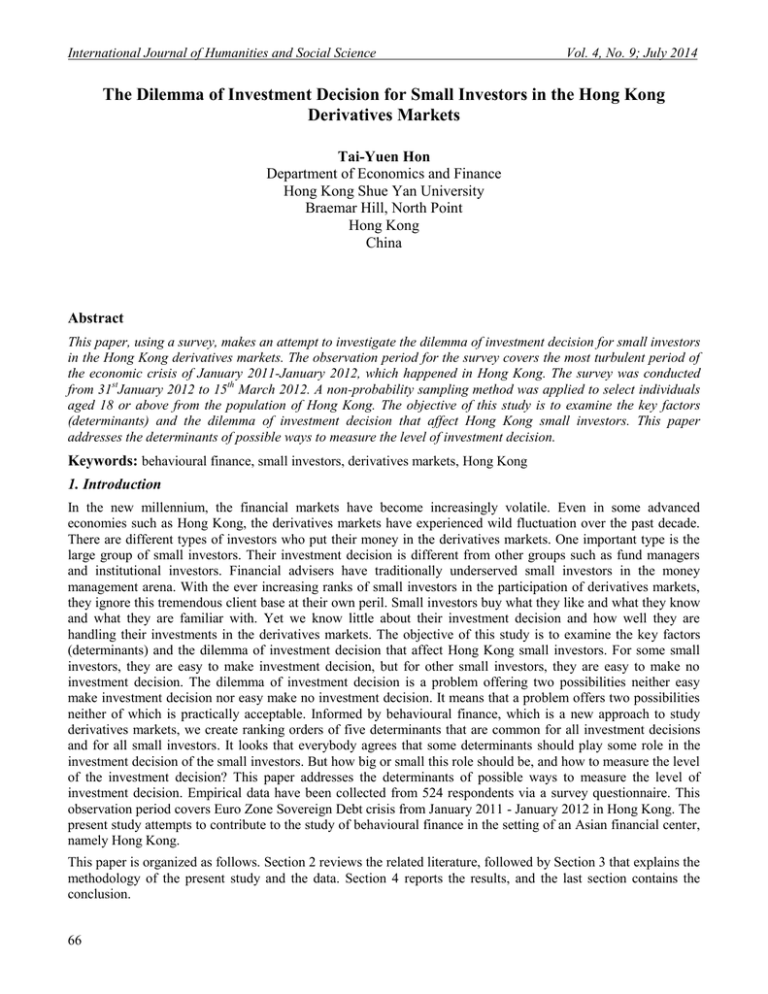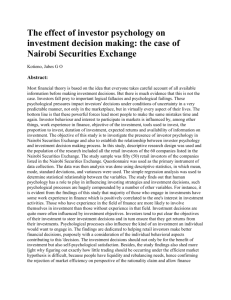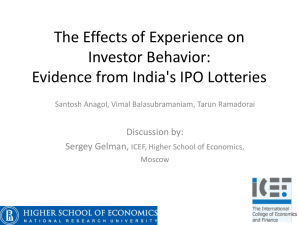Document 10465866
advertisement

International Journal of Humanities and Social Science
Vol. 4, No. 9; July 2014
The Dilemma of Investment Decision for Small Investors in the Hong Kong
Derivatives Markets
Tai-Yuen Hon
Department of Economics and Finance
Hong Kong Shue Yan University
Braemar Hill, North Point
Hong Kong
China
Abstract
This paper, using a survey, makes an attempt to investigate the dilemma of investment decision for small investors
in the Hong Kong derivatives markets. The observation period for the survey covers the most turbulent period of
the economic crisis of January 2011-January 2012, which happened in Hong Kong. The survey was conducted
from 31stJanuary 2012 to 15th March 2012. A non-probability sampling method was applied to select individuals
aged 18 or above from the population of Hong Kong. The objective of this study is to examine the key factors
(determinants) and the dilemma of investment decision that affect Hong Kong small investors. This paper
addresses the determinants of possible ways to measure the level of investment decision.
Keywords: behavioural finance, small investors, derivatives markets, Hong Kong
1. Introduction
In the new millennium, the financial markets have become increasingly volatile. Even in some advanced
economies such as Hong Kong, the derivatives markets have experienced wild fluctuation over the past decade.
There are different types of investors who put their money in the derivatives markets. One important type is the
large group of small investors. Their investment decision is different from other groups such as fund managers
and institutional investors. Financial advisers have traditionally underserved small investors in the money
management arena. With the ever increasing ranks of small investors in the participation of derivatives markets,
they ignore this tremendous client base at their own peril. Small investors buy what they like and what they know
and what they are familiar with. Yet we know little about their investment decision and how well they are
handling their investments in the derivatives markets. The objective of this study is to examine the key factors
(determinants) and the dilemma of investment decision that affect Hong Kong small investors. For some small
investors, they are easy to make investment decision, but for other small investors, they are easy to make no
investment decision. The dilemma of investment decision is a problem offering two possibilities neither easy
make investment decision nor easy make no investment decision. It means that a problem offers two possibilities
neither of which is practically acceptable. Informed by behavioural finance, which is a new approach to study
derivatives markets, we create ranking orders of five determinants that are common for all investment decisions
and for all small investors. It looks that everybody agrees that some determinants should play some role in the
investment decision of the small investors. But how big or small this role should be, and how to measure the level
of the investment decision? This paper addresses the determinants of possible ways to measure the level of
investment decision. Empirical data have been collected from 524 respondents via a survey questionnaire. This
observation period covers Euro Zone Sovereign Debt crisis from January 2011 - January 2012 in Hong Kong. The
present study attempts to contribute to the study of behavioural finance in the setting of an Asian financial center,
namely Hong Kong.
This paper is organized as follows. Section 2 reviews the related literature, followed by Section 3 that explains the
methodology of the present study and the data. Section 4 reports the results, and the last section contains the
conclusion.
66
© Center for Promoting Ideas, USA
www.ijhssnet.com
2. Literature Review
Although many personal and situational factors may influence the behaviour of small investors in the derivatives
markets, research on this topic is sparse. Previous studies revealed that interpersonal influence (Hoffmann and
Broekhuizen, 2009), knowledge (Wang, 2009), and some other personal factors such as gender and personality
traits (Durand et al., 2008) were crucial in explaining investor behaviour. However, it is important to explore the
psychological processes (such as perception, attitudes, learning, and motivation) that affect an individual’s
decisions regarding an investment. For example, an investor’s gender and educational level (i.e., individual
factors) may affect his or her knowledge and orientation in investment, which then influence the risk perception,
and finally his or her investment behaviour. Graham et al. (2009) noted that male investors, and investors with
larger portfolios or literacy levels, are more likely to perceive themselves as competent as are female investors
and investors with smaller portfolios or less education. Hoffmann and Post (2012) found that past returns
positively impact investors’ return expectations and risk tolerance, and negatively impact their risk perception.
Moreover, Korniotis and Kumar (2011) suggested that older people make better investment choices as they gain
more investment knowledge and experience, and questioned whether deterioration of their investment skills with
age was largely due to the adverse effects of cognitive ageing. Williams (2007) found little evidence that
demographic factors affect socially responsible investment decision.
3. Methods and Data
Before we begin using the survey data set for analysis, we need to ensure the survey results are reliable enough.
According to Carmines & Zeller (1979, pp.11-13), reliability focuses on the extent to which the empirical
indicator provides consistent results across repeated measurements. It should be noted that the measure used to
assess the statistical significance of the item was coefficient of variation (CV), which expresses the ratio of the
standard deviation to the arithmetic mean CV
S
.So, the higher the CV value, the greater the heterogeneity of
X
respondents’ views. Accordingly, it was considered the consensus had been achieved when the level of item was
on the statistically significant (that is CV 55.5% ). The CVs for each of questionnaire items have been inserted
to the Results of Investment Behaviour of Small Investors in Derivatives Markets in the Hong Kong Survey in the
Appendix. Taking a look at these CVs, we can find the maximum and minimum value is 55.5% and 19.7%
respectively with mean 38.2%.
Factor analysis is employed to identify the key factors that affect the investment decisions of small investors on
derivatives markets in Hong Kong. We agree that the pure investment decision and no investment decision are
absolutely opposite to each other in terms of key factors. Let create ranking order of determinants that are
common for all investment decisions: cognitive style, risk tolerance, return performance, reference group and
personal background. But why they are so different? To examine possible differences in the perceived importance
of the five key factors, our analyses indicate that out of four criteria (i.e., rotated principal component loadings,
scree test, Kaiser-Meyer-Olkin (KMO) and Bartlett’s test of Sphericity, reliability test) examined. This ranking is
different for every small investor. As a result, each small investor has used some key factors from the literature as
potential determinants of the investment decision. We can say even more; in the case of pure investment decision
and no investment decision these rankings are exactly opposite as we will show here. The dilemma for investment
decision is popular for small investors. Therefore, for some small investors, they will make relatively easy
investment decision, but for other small investors, they will make relatively easy no investment decision. Can
these differences be measured? Let try to do that using the idea of ranking correlation developed by the British
mathematician Kendall (1955) to measure these differences as differences between determinants ranking orders.
According to Abdi’s paper (2007) in the “Encyclopedia of Measurement and Statistics” , when we are comparing
two ordered sets we should look at the number of different pairs between the two sets which allow us to get
something which is called the “symmetric difference distance” between the two sets. The symmetric difference is
a set operation which associates to two sets the set of elements that belong to only one set.
2 x [d∆(P 1, P 2)]
N (N-1)
67
International Journal of Humanities and Social Science
Vol. 4, No. 9; July 2014
Where the symmetric difference distance between two sets of ordered pairs P 1 and P 2 is presented as
d∆( P 1, P 2 ). N is number of ranked elements (i.e. determinants), in our case N = 5. With N = 5 elements we
assume arbitrarily that first order is equal to 12345. Therefore, with two rank orders provided on N determinants,
there are N! (i.e. N! = 5! = 5 x 4 x 3 x 2 x 1 = 120) different possible outcomes (each corresponding to a given
possible order) to consider for computing the sampling distribution of Kendall coefficient can have values
between -1 and +1: -1 ≤ ≤ +1where -1 is the largest possible distance (equal to -1, obtained when one order is
the exact reverse of the other order) and +1 is the smallest one (equal to +1, obtained when both orders are
identical).The Kendall coefficient can be interpreted as the difference between the probability to have
determinants in the same order and the probability that they are in the different order:
P (same) – P (different).
Let use the Kendal coefficient between two ordered sets for selected five small investors: P, Q, R, S and T.
The data for the present study were collected from small investors in Hong Kong via a questionnaire survey. Its
main purpose is to collect the opinions, investment behaviour, and financial decision making of the respondents in
the Hong Kong derivatives markets. Since the majority of Hong Kong’s population is Chinese, the questionnaire
was written in Chinese. After a pilot survey and refinement for the questionnaire, and then a detailed briefing for
the enumerators (our students), the survey was carried out in the period from 31 stJanuary 2012 to15thMarch 2012
with the questionnaire being completed by 524 respondents.
This questionnaire consists of 11 questions (items): 3 questions for personal background, 2 questions for return
performance, 2 questions for risk tolerance, 3 questions for cognitive style, 1 question for reference group. We
selected the respondents using non-probability sampling (snowball method). The target population is the small
investors in the Hong Kong derivatives markets. The respondents were requested to provide an estimated
percentage breakdown of their average return on investment of derivative products during the observation period.
Our data set has fulfilled the following conditions: (1) A minimum of five subjects per item is required for factor
analysis; (2) A sample of 100 subjects is acceptable but sample sizes of over 200 are preferable.
4. Results
The basic information about the respondents is depicted in Appendix. The majority of the respondents (62.8%)
are in the age group of 18-34. More than a half of these respondents (52.1%) have less than 3 years of experience
of investing in financial market. About one-third of them have an average return of less than 10% and another
one-third of them have an average return of 10-30%. Most of these respondents reported that they have a medium
(40.9%) or high (36.4%) level of tolerance for investment risk. A high percentage of them think that the risk level
in investing financial derivatives is high (53.7%) or very high (18.5%). The respondents also reported that they
obtained the information and opinion that affected their investment decision from various sources such as Internet
(37.8%), newspapers, TV, magazines, etc. (25.8%).
Table 1. Factor Correlation Matrix
Item
2
1
0.449**
2
3
4
5
6
7
8
9
3
0.595**
0.408**
4
0.007
0.200
0.109*
5
-0.087*
-0.169**
-0.101*
-0.607**
6
-0.028
0.035
0.045
0.101*
0.044
7
-0.215**
-0.084*
-0.092*
0.265**
-0.022
0.305**
8
-0.089*
-0.063
-0.080
-0197**
0.168**
0.039
-0.136**
9
0.065
0.158**
0.077
0.107*
-0.086*
-0.097*
-0.008
-0.168**
10
0.094**
0.044
0.126**
0.137**
-0.161**
0.093*
0.151**
0.171**
0.146**
11
-0.058
0.154**
-0.007
0.129**
-0.120**
-0.006
0.094*
-0.055
0.132**
10
0.071
*Correlation is significant at the 0.05 level (one-tailed) and ** Correlation is significant at 0.01 level (one-tailed).
Kaiser-Meyer-Olkin (KMO) index: 0.612, Bartlett’s test of Sphericity: ρ<0.000.
68
© Center for Promoting Ideas, USA
www.ijhssnet.com
To identify the underlying dimensions of the items, which are perceived to be important by the respondents, the
11 items were then factor analysed. Initial visual assessment of the correlation matrix indicated a considerable
degree of inter-factor correlation (see Table 1). In addition, from the correlation matrix, the Bartlett’s test of
Sphericity (ρ< 0.000) and the Kaiser-Meyer-Olkin (KMO) measure of sampling adequacy index (with a value of
0.612) confirm the appropriateness of the data for exploratory factor analysis.
Table 2: Principal Components Analysis
Item
Communality
Factor
Eigenvalue
1
2
3
4
5
6
7
8
9
10
11
0.761
0.653
0.702
0.810
0.811
0.717
0.656
0.542
0.583
0.501
0.782
A
B
C
D
E
2.319
1.812
1.267
1.13
1.017
Per cent of
variance
21.077
16.470
11.520
10.030
9.244
Cumulative
per cent
21.077
37.547
49.067
59.097
68.342
Given that our aim was to identify the minimum number of factors that would account for the maximum portion
of variance of original items, the principal component analysis was selected (Nunnally, 1978) to reduce the
number of factors with an eigenvalue greater than 1. Accumulative percentage of variance explained being greater
than 50% is the criteria used in determining the number of factors. On the basis of the criteria, five factors were
extracted (see Table 2). The five factors, collectively, accounted for a satisfactory 68.342% of the variance.
Communality values in between 1.0 and 0 indicate partial overlapping between the items and the factors in what
they measure. Furthermore, the communality column, provides further evidence of the overall significance, albeit,
moderate, of the solution. The underlying rationale for the Scree test is based on the fact that within a set of items,
a limited number of factors are measured more precisely than the others. By graphing the eigenvalues, we found
that the smaller factors form a straight line sloping downward. The dominant factors will fall above the line.
Figure 1: A Scree Plot
Scree Plot
2.5
2.0
1.5
Eigenvalue
1.0
.5
0.0
1
2
3
4
5
6
7
8
9
10
11
12
Component Number
69
International Journal of Humanities and Social Science
Vol. 4, No. 9; July 2014
Figure 1 demonstrates a five-factor solution is obtained. Having established that the analysis has provided a stable
solution, examination of the varimax-rotated factor loading was performed (see Table 3).
Table 3. Varimax-Rotated Principal Component Loadings
Item
1
2
3
4
5
6
7
8
9
10
11
A
0.851
0.713
0.826
B
Factors
C
D
E
0.864
-0.885
0.833
0.718
-0.707
0.540
0.655
0.873
Item name
Age
Personal Income
Investment Experience
Average Return
Satisfaction
Risk Tolerance
Investment Portfolio
Risk Level
Sell/Close out Position
Investor Education
Information/Opinion
Factor
A
A
A
B
B
C
C
D
D
D
E
The cumulative factors revealed that the first factor accounts for 21.077% of the variance. The second factor
accounts for 37.547% of the variance. The third factor accounts for 49.067% of the variance. The fourth factor
accounts for 59.097% of the variance. Finally, the fifth factor accounts for 68.342% of the variance. After the
rotation, there are no negative loadings on any consequence on either factor A, factor C, or factor E. The rotated
factors that represent the meaningful constructs ordinarily should not exhibit these large negative loadings. Thus,
we eliminated item 5 in factor B and item 8 in factor D. Finally, we found five factors affecting the behavior of
small investors in the derivatives markets in Hong Kong as follows: factor A might be interpreted as personal
background which include age, personal income, and investment experience; factor B as return performance
which include average income on investment of derivative products; factor C as risk tolerance which includes
personal level of tolerance for investment risk and the total amount in small investor’s portfolio of derivative
products; factor D as cognitive style which includes cognitive of small investors sell or close their position of time
length in derivative products and the cognitive of investor education provided by the government; and factor E as
reference group, which includes commentators’ recommendations from newspapers/TV/magazines,
relatives/friends, Internet, investment consultants, and companies’ annual reports. The specific name given to
each factor is designed to reflect an item or notion that conceptually relates to the rest of the items under a
particular factor. The reliability test is reported in Table 4. At this point only initial of internal reliability of the
expected factors was performed in the form of Cronbach’s coefficient α. For the purposes of this study, the cut-off
value adopted was 0.5 (Nunnally, 1978) and the acceptable benchmark level of corrected item-total correlation
was set above 0.3.
Table 4. Internal Consistency and Related Decisions of First Structure
Corrected itemtotal correlation
α value
Decision
Factor A (Personal Background)
Age
Personal Income
Investment Experience
0.5060
0.4744
0.5123
0.6662
Retained
Factor C (Risk Tolerance)
Risk Tolerance
Investment Portfolio
0.3036
0.3036
0.4634
Eliminated
Factor D (Cognitive Style)
Sell/Close out Position
Investor Education
0.1458
0.1458
0.2527
Eliminated
Factors and items
70
© Center for Promoting Ideas, USA
www.ijhssnet.com
Table 5. Internal Consistency of Final Revised Structure
Items
Factor A (Personal Background)
Age
Personal Income
Investment Experience
Number of item
Corrected itemtotal correlation
α value
3
0.5060
0.4744
0.5123
0.6662
Factor B (Return Performance)
Average Return
1
Factor E (Reference Group)
Information/Opinion
1
Following the decision relating to the internal reliability, the factors were re-specified. This was undertaken to
further reduce the number of factors. The internal reliability of the first structure was tested and the decision
results provide evidence as to the weakness of the structure since one factor (factor A) exceeded the adopted
criteria. It is found that factor A contains three items and relates to “personal background”. Factor C is made up of
two items and refers to “risk tolerance”. Finally, factor D comprises two items and deal with “cognitive style”.
The derived scales appear to possess moderate to weak internal consistency. So, we eliminated both factors C and
D (see Table 5).To examine possible differences in the perceived importance of the five factors, our analyses
indicate that out of four criteria (i.e., rotated principal component loadings, scree test, KMO and Bartlett’s test,
reliability test) examined, only three factors (personal background, reference group, return performance) are
significant. Based on these results, we can derive the following ascending order of importance:
1. Factor D: Cognitive Style (Style)
2. Factor C: Risk Tolerance (Tolerance)
3. Factor B: Return Performance (Performance)
4. Factor E: Reference Group (Group)
5. Factor A: Personal Background (Background)
Let create ranking orders of the five determinants that are common for all investment decision and respectively
for all small investors. To get the determinants ranking orders for each small investor, we should follow ascending
order of importance.
The determinants order the pure investment decision: [Style, Tolerance, Performance, Group, Background] with
the following ranking: R 1 = [1, 2, 3, 4, 5].
This ranking is different for every small investor. As a result, each small investor has different level of investment
decision. Let find the Kendall rank correlation coefficients for small investor using initially the pure investment
decision ranking order as the standard, and later we will do the same using the no investment decision ranking
order as the standard.
Choice of small investors: P, Q, R, S and T.
Small investor P: [Tolerance, Performance, Style, Background, Group]
with the ranking: R 2 = [2, 3, 1, 5, 4].
We are comparing two ordered sets. We should look at the number of different pairs between two sets which
allow us to get something which is called the “symmetric difference distance” between these two sets.
2 x [d∆(P 1, P 2)]
N (N-1)
71
International Journal of Humanities and Social Science
Vol. 4, No. 9; July 2014
Where the symmetric difference distance between two sets of ordered pairs P 1 and P 2 is presented as
d∆( P 1, P 2 ). N is number of ranked determinants, in our case N = 5. Kendall coefficient can have values between
-1 and +1: -1 ≤ ≤ +1 where -1 is the largest possible distance and +1 is the smallest one.
The Kendall coefficient of correlation of determinants ranking for the small investor P and the pure investment
decision is 0.4:
P 1 = {[1, 2], [1, 3], [1, 4], [1, 5], [2, 3], [2, 4], [2, 5], [3, 4], [3, 5], [4, 5]}.
P 2 = {[2, 3], [2, 1], [2, 5], [2, 4], [3, 1], [3, 5], [3, 4], [1, 5], [1, 4], [5, 4]}.
The set of pairs which are in only one set of ordered pairs is {[1, 2], [2, 1], [1, 3], [3, 1], [4, 5], [5, 4]}. So, the
value of d∆( P 1, P 2 ) = 6. That means that the value of the Kendall rank correlation coefficient between two
orders of investment decision is:
1
26
0.4
5 4
Small investor Q: [Background, Group, Performance, Tolerance, Style]
with the ranking: R 3 = [5, 4, 3, 2, 1].
P 1 = {[1, 2], [1, 3], [1, 4], [1, 5], [2, 3], [2, 4], [2, 5], [3, 4], [3, 5], [4, 5]}.
P 3 = {[5, 4], [5, 3], [5, 2], [5, 1], [4, 3], [4, 2], [4, 1], [3, 2], [3, 1], [2, 1]}.
The set of pairs which are in only one set of ordered pairs is {[1, 2], [2, 1], [1, 3], [3, 1], [1, 4], [4, 1], [1, 5], [5, 1],
[2, 3], [3, 2], [2, 5], [5, 2], [3, 4], [4, 3], [3, 5], [5, 3], [4, 5], [5, 4]}. So, the value of d∆( P 1, P 3 ) = 18. That means
that the value of the Kendall rank correlation coefficient between two orders of determinants is:
1
2 18
0.8
5 4
Small investor R: [Performance, Background, Style, Tolerance, Group]
with the ranking: R 4 = [3, 5, 1, 2, 4].
P 1 = {[1, 2], [1, 3], [1, 4], [1, 5], [2, 3], [2, 4], [2, 5], [3, 4], [3, 5], [4, 5]}.
P 4 = {[3, 5], [3, 1], [3, 2], [3, 4], [5, 1], [5, 2], [5, 4], [1, 2], [1, 4], [2, 4]}.
The set of pairs which are in only one set of ordered pairs is {[1, 3], [3, 1], [1, 5], [5, 1], [2, 3], [3, 2], [2, 5], [5, 2],
[4, 5], [5, 4]}. So, the value of d∆( P 1, P 4 ) = 10. That means that the value of the Kendall rank correlation
coefficient between two orders of determinants is:
1
2 10
0
5 4
Small investor S: [Tolerance, Style, Performance, Background, Group]
with the ranking: R 5 = [2, 1, 3, 5, 4].
P 1 = {[1, 2], [1, 3], [1, 4], [1, 5], [2, 3], [2, 4], [2, 5], [3, 4], [3, 5], [4, 5]}.
P 5 = {[2, 1], [2, 3], [2, 5], [2, 4], [1, 3], [1, 5], [1, 4], [3, 5], [3, 4], [5, 4]}.
The set of pairs which are in only one set of ordered pairs is {[1, 2], [2, 1], [4, 5], [5, 4]}. So, the value of
d∆( P 1, P 5 ) = 4. That means that the value of the Kendall rank correlation coefficient between two orders of
determinants is:
1
2 4
0.6
5 4
Small investor T: [Performance, Style, Tolerance, Background, Group]
with the ranking: R 6 = [3, 1, 2, 5, 4].
72
© Center for Promoting Ideas, USA
www.ijhssnet.com
P 1 = {[1, 2], [1, 3], [1, 4], [1, 5], [2, 3], [2, 4], [2, 5], [3, 4], [3, 5], [4, 5]}.
P 6 = {[3, 1], [3, 2], [3, 5], [3, 4], [1, 2], [1, 5], [1, 4], [2, 5], [2, 4], [5, 4]}.
The set of pairs which are in only one set of ordered pairs is {[1, 3], [3, 1], [2, 3], [3, 2], [4, 5], [5, 4]}. So, the
value of d∆( P 1, P 6 ) = 6. That means that the value of the Kendall rank correlation coefficient between two orders
of determinants is:
1
26
0.4
5 4
Because the determinants ranking order of the no investment decision is extremely opposite to the determinants
ranking order of the pure investment decision. The Kendall rank correlation coefficient between them is = - 1.
Respectively for the above discussed small investors, the Kendall rank correlation coefficients with the no
investment decision order would be: -0.4 for small investor P and small investor T; -0.6 for small investor S; 0.8
for small investor Q and 0 for small investor R.
We can conclude that small investor S is the closest to the pure investment decision setting priority and small
investor Q is the farthest from the pure investment decision among them. Small investor R is a classic case of
dilemma for investment decisions.
5. Conclusion
Using factor analysis, we identify five factors (determinants) that capture the investment decision of small
investors in the Hong Kong derivatives markets. Their investment decision has uniform views as to the ascending
order of importance of cognitive style, risk tolerance, return performance, reference group, and personal
background. To get the determinants ranking orders for small investor in the pure investment decision, we should
follow ascending order of importance. This ranking is different for every small investor. As a result, each small
investor has different levels of investment decision. We have reported evidence from five small investors (P, Q,
R, S, T) that the determinants ranking order of the no investment decision is extremely opposite to the
determinants ranking order of the pure investment decision. The Kendall rank correlation coefficient between
them is = - 1. Respectively for the above discussed small investors, the Kendall rank correlation coefficients
with the no investment decision order would be: -0.4 for small investor P and small investor T; -0.6 for small
investor S; 0.8 for small investor Q and 0 for small investor R. We can conclude that small investor S is the
closest to the pure investment decision setting priority and small investor Q is the farthest from the pure
investment decision among them. Small investor R is a classic case of dilemma for investment decision. This
implies that financial advisors can approach the customers (small investors) with Kendall rank correlation
coefficients greater than zero. These customers will make relatively easy investment decision in the Hong Kong
derivatives markets.
73
International Journal of Humanities and Social Science
Vol. 4, No. 9; July 2014
Appendix
Results of Investment Behaviour of Small Investors in Derivatives Markets in the Hong Kong Survey
Survey Period: 31stJanuary 2012 to15thMarch 2012
____________________________________________________________________________________________________
Item
1.
2.
3.
4.
5.
74
Age group: (CV = 55.4%)
a
18 – 24 years old
b
25 – 34 years old
c
35 – 44 years old
d
45 – 54 years old
e
55 – 64 years old
f
over 65 years old
Total
33.0%
29.8%
14.5%
15.3%
6.5%
1.0%
100%
Average monthly income: (CV = 55.5%)
a
Below HK$5,000
b
HK$5,000 -HK$9,999
c
HK$10,000 - HK$14,999
d
HK$15,000 - HK$19,999
e
HK$20,000 - HK$24,999
f
HK$25,000 - HK$29,999
g
HK$30,000 - HK$49,999
h
HK$50,000 or above
Total
21.1%
13.6%
16.9%
18.0%
14.8%
6.1%
7.3%
2.3%
100%
How long have you invested in financial market? (CV = 40.7%)
a
Nil
b
Less than 1 year
c
1 year to under 3 years
d
3 year to under 5 years
e
5 year to under 10 years
f
10 years or above
Total
8.2%
18.1%
34.0%
17.6%
13.5%
8.6%
100%
What is your average return on investment of derivative products? (CV = 41.8%)
a
Loss
b
Average Return less than 10%
c
Average Return 10% to under 30%
d
Average Return 30% to under 50%
e
Average Return 50% to under 100%
f
Average Return 100% or above
Total
18.2%
34.2%
32.8%
11.5%
2.9%
0.5%
100%
During January 2011 to January 2012, do you satisfy with average returns of your financial derivatives
investment? (CV = 32%)
a
Very satisfied
2.2%
b
Satisfied
30.4%
c
Normal
37.6%
d
Dissatisfied
21.3%
e
Very dissatisfied
8.6%
Total
100%
© Center for Promoting Ideas, USA
6.
www.ijhssnet.com
What is your personal level of tolerance for investment risk? (CV = 26.3%)
a
Very Low
b
Low
c
Medium
d
High
e
Very High
Total
2.2%
14.8%
40.9%
36.4%
5.7%
100%
7.
Comparing to the total amount in your investment portfolio, how much do you invest in derivative
products? (CV = 43.5%)
a
Less than10%
22.0%
b
10% to under 30 %
45.9%
c
30% to under 50 %
21.8%
d
50% to under 100%
7.4%
e
100%
2.9%
Total
100%
8.
What do you think the risk level in investing financial derivatives? (CV = 19.7%)
a
Very Low Risk
b
Low Risk
c
Medium Risk
d
High Risk
e
Very High Risk
Total
9.
10.
11.
When did you mostly sell or close out your position when you invested in financial derivatives
during January 2011 to January 2012? (CV = 32.6%)
a
Within one day
b
Within one week
c
Within one month
d
Within three months
e
Within one year
f
More than one year
Total
Do you think the small investor education provided by the related government department is
(CV = 36.3%)
a
Very Inadequate
b
Inadequate
c
No Opinion
e
Adequate
f
Very Adequate
Total
0.4%
3.4%
23.9%
53.7%
18.5%
100%
3.4%
28.6%
40.8%
19.7%
6.7%
0.7%
100%
adequate?
13.8%
44.6%
31.5%
9.2%
1.0%
100%
Which type of information and opinion will affect your decision in investing financial derivative mostly?
(CV = 36.3%)
a
Nil
2.9%
b
Newspapers, TV, magazines, etc.
25.8%
c
Relatives and friends
10.3%
d
Internet
37.8%
e
Investment Consultants
17.2%
f
Companies’ Annual Reports
4.8%
g
Others
1.2%
Total
100%
Note: percentage not always adding up to 100 due to rounding-up.
75
International Journal of Humanities and Social Science
Vol. 4, No. 9; July 2014
References
Abdi, H., (2007).The Kendall Rank Correlation Coefficient. In N. Salkind (Ed.) Encyclopedia of Measurement
and Statistics, 2, (pp.508-510). Thousand Oaks (CA): Sage
Carmines, E. G. and Zeller, R.A. (1979). Reliability and validity assessment (Vol.17): Sage.
Durand, R.B., Newby, R. and Sanghani, J. (2008). An Intimate Portrait of the Individual Investor. The Journal of
Behavioral Finance, 9, 193-208.
Graham, J.R., Harvey, C. R. and Huang, H. (2009). Investor Competence, Trading Frequency and Home Bias.
Management Science, 55(7), 1094–1106.
Hoffmann, A. O. I. and Broekhuizen, T. L. J. (2009). Susceptibility to and Impact of Interpersonal Influence in
An Investment Context. Journal of the Academy of Marketing Science, 37, 488-503.
Hoffmann, A. O. I. and Post, T. (2012). What Makes Investors Optimistic? What Makes Them Afraid? Working
paper, Maastricht University and Netspar, The Netherlands, 1-40.
Kendall, M.G., (1955). Rank Correlation Methods. New York: Hafner Publishing Co.
Korniotis, G. M. and Kumar, A. (2011). Do Older Investors Make Better Investment Decision? The Review of
Economics and Statistics, 93(1), 244-265.
Nunnally, J. C.,(1978). Psychometric Theory. (2nd Ed.), New York: McGraw-Hill.
Wang, A.,(2009). Interplay of Investors' Financial Knowledge and Risk Taking. The Journal of Behavioral
Finance, 10, 204-213.
Williams, G.,(2007). Some Determinants of the Socially responsible Investment Decision: A Cross-Country
Study. The Journal of Behavioral Finance, 8(1), 43-57.
76









